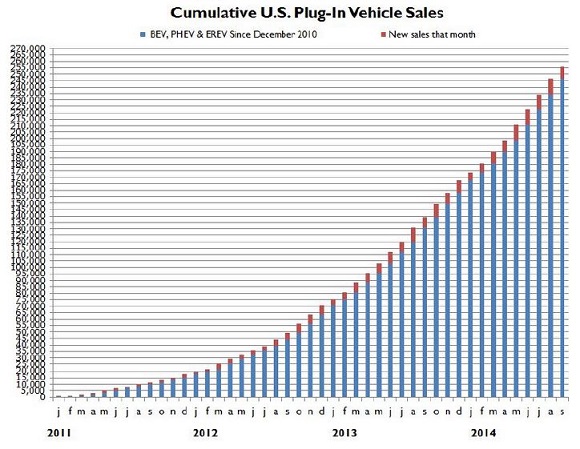As we see it today, there are three major industry disruptions confronting our auto dealer merchants: plug-in vehicles and alternative powertrains, gas price fluctuation, and threats to the dealership model.
Plug-Ins
Drivers of plug-in vehicles can be considered the least economically motivated and most ecologically-minded on the road. Clearly, there is consistent, rising demand shown in the graph below. So much so that auto dealers sold 37% more plug-in vehicles in the first six months of 2014 than they did in 2013. Looking at California alone, drivers doubled their plug-in purchases from 2012 to 2013, totaling over 42,000 plug-ins (and 2014 numbers are expected to drastically increase as well).

Vehicle manufacturers are not the only ones noticing the change. U.S. companies are also taking notice. With this rising demand, some corporations are installing charging stations on their campuses to encourage employees to buy electricity and to provide a nice perk to employees who already have plug-ins.
Gas Prices Tumbling
The break-even date for hybrids is less the higher gas prices are, and vice versa. Rewind to 2008, when the average gas price peaked at $4.05 – hybrids enjoyed a shorter break-even date. Fast forward to the present day and the average price sits at $2.89 per gallon. These tumbling prices have lengthened the hybrid break-even date.
But as we all know gas prices can fluctuate dramatically. The short-term advantages of lower gas prices ultimately may not deter consumers from purchasing hybrids, or plug-ins for that matter. In fact, gas prices for the next 10 years are forecasted to steadily increase. This may bode well for Toyota and its Prius, which it introduced in 1997 and sold at a loss for several years to establish the market. Fortunately for Toyota this year the Prius is on pace to sell 7 million hybrids. This just goes to show that the automotive market can be very slow to evolve. But when it does, the payoff can be huge.
Recalls, Tesla & the Dealership Model
Congress created the recall system to be sure that new car dealerships performed all necessary repairs on recalled vehicles. In 2014 alone automotive industry analysts estimate 11 million vehicles have been recalled. This public service was designed to protect drivers and the general public. But consumers and media alike seem to have forgotten to thank dealerships for their efforts.
Instead, they’ve questioned the need for dealerships in the first place because of Tesla’s direct sales approach. Tesla is not the first manufacturer to try the direct-to-consumer business model. General Motors and Ford both attempted it, but their experiments failed. They lost money and market share in the regions they tried the direct model.
Having experienced my own share of recalls, I take comfort in knowing the dealership’s expertise handles the necessary repairs. In doing so, you can develop some goodwill and establish a stronger relationship with your customer base in the process – creating higher sales and retention rates in the future.
NADA forecasts that “16.94 million new cars and light trucks will be purchased or leased in the United States in 2015.”
So how do you adapt to so much industry volatility to get your piece of the 2015 pie? How can you stay ahead and increase vehicle sales at your dealership?
Attending NADA (the Automotive Industry event of the year) can certainly go a long way towards helping. We’ve been attending for twenty-plus years.


